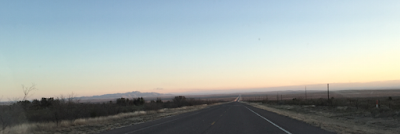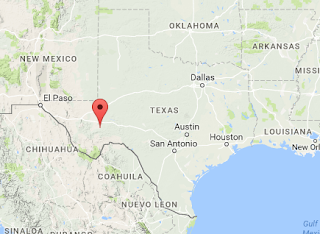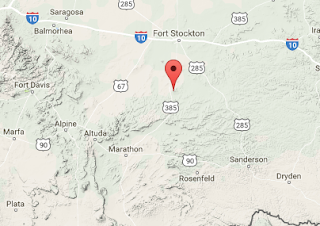

As those of you who have been following this blog know, I am at work on a book about Far West Texas and, apropos of that, hosting the Marfa Mondays Podcasting Project. So in addition to reading about Far West Texas and related subjects, and interviewing artists and many other interesting people, I’ve been doing a heap of driving all over the place out there.
Driving east or west on I-10 or I-20 or 90 is to barrel along with the steady flow of big rigs, pickup trucks, RVs and SUVs; driving north-south, on the other hand, it gets very lonely, very strange, very fast.
Here is a photo* I took with my iPhone through the windshield while heading south on US-385 from Fort Stockton to Marathon. That jumble of hills over to the left is the Sierra Madera, which sits on the vast La Escalera Ranch, one of the largest ranches in Texas. Although I did not know it at the time, the highway was about to blaze me right through the Sierra Madera Astrobleme.
[*Normally I would never fool around with my smartphone while driving, but I had been driving out here for sometime and not seen a single vehicle, in either direction. I daresay I could have taken got out of the car and taken a siesta in the middle of the road.]


The Sierra Madera is indeed on Google maps, but neither of the maps I carried with me that day, the AAA and the Geological Highway Map of Texas, noted it, so I was wholly unprepared for the sight, on the open plains, well before the Glass Mountains, of the strange-looking huddle of the Sierra Madera off to the east– and all bathed in the golden-orange glow of sunset. Alas, my photo does not do its stunning gorgeousness a shred of justice.
It turns out that the Sierra Madera is an extremely rare “cryptoexplosion structure,” in this case, a crater with a central mountain range raised not by volcanic or tectonic forces, but by the rebound from the impact of an unknown extraterrestrial object. The mountains and the approximately 6 mile-in-diameter crater, so eroded over some nearly 100 million years that I did not recognize it as I drove through it, are together known as the Sierra Madera Astrobleme.
An astrobleme is an eroded remnant of a large crater made by the impact of a meteorite or comet. The term, first used in the mid-20th century, is from the Greek astron, star, and blema, wound.
What was that object that slammed into the earth those nearly 100 million years ago? I searched the literature but could not find any description beyond “approximately spherical.” So I wrote to Dr. Robert Beaufort, who host the United States Meteorite Impact Craters website. He kindly answered:
“Identifying the class of meteorite that caused a particular impact crater is a genuinely difficult task… Because we are talking about gargantuan numbers of nuclear bombs worth of heat and shock energy, the impacting body itself, which is pretty tiny compared to the size of the crater, winds up distributed as parts per million or billion among the melted and/or redistributed target rocks remaining in and around the crater. Finding traces of the impactor is pretty straightforward if you have a mass spectrometer to play with (which I don’t), but actually telling which specific type of asteroid and associated meteorite you are dealing with is much more difficult. Scientists have looked at differences in bulk elemental ratios and at differences in isotope ratios in different classes of meteorites, and found cases where the same characteristic ratios could be discerned, even though they were diluted to parts per gazillion in the earth rock at an impact site. It is tricky work, and depends upon being able to clearly evaluate terrestrial background abundances, and so forth, but we are getting better at it with each passing decade. I don’t think it has been done for Sierra Madera. There is a very good chapter on the subject in Osinski and Pierazzo’s book, Impact Cratering: Processes and Products. Dr. Christian Koberl springs to mind as one of the world’s notable authorities on the subject of projectile identification at impact crater sites.”
What was going on 100 million years ago? This would have been the Late Cretaceous or Early Tertiary, when Tyrannosaurus roamed and Quetzalcoatlus northropi, a pterosaur the size of a small jet airplane, cast his shadow from overhead. (Seems the flora and fauna had a few more million years to go… 66 million years ago came Chicxulub and the great extinction.)
The literature I could Google up on the Sierra Madera Astrobleme has a great deal of detail on shatter cones and various types of rock, as well as gravitational and magnetic anomalies. But as for a description for the layman, or shall we say, the average Tyrannosaurus Rex, of what the impact might have sounded like and how it might have affected the atmosphere, or caused mega-tsunamis, no dice.
Would the Sierra Madera have appeared as an island? It seems that those many millions of years ago the area was then underneath the so-called Western Interior Seaway. The Davis Mountains— the Texas Alps– lying beyond the horizon to the northwest, would not emerge until the volcanic frenzy of (gosh, only) 35 million years ago.
Dear reader, if you have more information about the Sierra Madera Astrobleme, please do write.
Informative links:
> “When Texas Was at the Bottom of the Sea” by Olivia Judson, Smithsonian Magazine, January 2015.
> University of Texas of the Permian Basin webpage on the Sierra Madera Astrobleme
All the crunchy geology. Plus the hypothetical reconstruction of the event.
> “Hydrocone Modeling of the Sierra Madera Impact Structure” by Tamara J. Goldin et al. Meteoritics and Planetary Science, 2006.
Extra-crunchy.
> “Geology of the Sierra Madera Cryptoexplosion Structure, Pecos County, Texas” by H.G. Wilshire, et al. U.S. Geological Survey Professional Paper No. 599, 1972.
Extra-extra-crunchy with shatter cones.
> United States Meteorite Impact Craters: Page on the Sierra Madera Crater
Good variety of photographs and information by Robert Beauford, PhD. He writes:
“This is one of the largest impact craters in the United States, and even after having worked on 4 to 5 km craters for several years, I found it challenging to take in the scale of the structure. It defines the shape of the vast, open landscape in every direction.”
> Purdue University’s Impact Earth! Famous Craters page.
Alas, it does not include the Sierra Madera Astrobleme. But fascinating nonetheless.
> Astronaut’s Guide to Terrestrial Impact Cratersby R.A.F. Grieve, et al. LP Technical Report Number 88-03, Lunar and Planetary Institute, NASA, 1988
(See Sierra Madera, p. 13.)
#
P.S. Wiggy synchronicity du jour: Given that the Sierra Madera Astrobleme is near the Glass Mountains, it raised my eyebrows to come upon this webpage with the Ames Astrobleme Museum and the Gloss Mountains of Oklahoma:


Notes on Wolfgang Schivelbusch’s The Railway Journey:
The Industrialization of Time and Space in the Nineteenth Century
Q & A: Amy Hale Auker, on Ordinary Skin: Essays from Willow Springs
Find out more about
C.M. Mayo’s books, articles, podcasts, and more.

